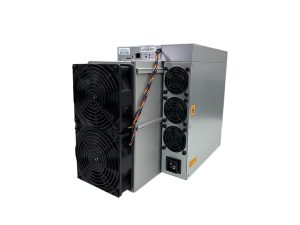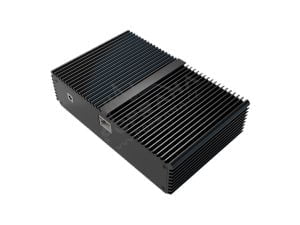Kaspa ASICs
- Quick Transactions: Thanks to the DAG structure, it can Kaspa process transactions almost instantly, making it one of the fastest cryptocurrencies on the market. ⚡️
- Scalability: Kaspa is able to provide high network throughput, supporting the simultaneous processing of a large number of transactions without compromising speed or security. 📈
- Decentralization: Kaspa it maintains a high level of decentralization thanks to its technology and the wide distribution of nodes around the world. 🌍
- Open source code: Projects Kaspa it is completely open, allowing the developer community to contribute to its development and improvement. 👨💻👩💻
Kaspa ASICs offers an interesting approach to solving the scalability and speed issues that many cryptocurrencies face. However, as with any investment asset, it is important to do your own research and assess the potential risks and benefits before investing.

Displaying all 17 results
-
ASIC mining, crypto-mining, Kaspa ASICs
💰 KASPA: 1 TH/s ⚙️ ALGORITHM: KHEAVYHASH ⚡ WATT: 600W Discount when paying in USDT — You will receive a normal invoice and onBest price guarantee! Od 68, 833.88 CZK Select options -
ASIC mining, crypto-mining, Kaspa ASICs
💰 KASPA: 12 TH/s ⚙️ ALGORITHM: KHEAVYHASH ⚡ WATT: 3400 W Production time: April 4.20- May 5.05Best price guarantee! Od 257, 792.56 CZK Select options -
ASIC mining, crypto-mining, Kaspa ASICs
💰 KASPA: 1.18 TH/s ⚙️ ALGORITHM: KHEAVYHASH ⚡ WATT: 400 W Production period: April 25- May 10Best price guarantee! Origfinal price was: 102 CZK.64, 731.40 CZKCurrent price is: 64 CZK. | 64, 731.40 CZK without WAT Buy -
ASIC mining, crypto-mining, Kaspa ASICs
💰 KASPA: 20 TH/s ⚙️ ALGORITHM: KHEAVYHASH ⚡ WATT: 3000WBest price guarantee! Origfinal price was: 931 CZK.729, 795.87 CZKCurrent price is: 729 CZK. | 729, 795.87 CZK without WAT Buy -
ASIC mining, crypto-mining, Kaspa ASICs
💰 KASPA: 21 TH/s ⚙️ ALGORITHM: KHEAVYHASH ⚡ WATT: 3150 W Delivery time: Choose from the options belowBest price guarantee! Od 810, 076.03 CZK Select options -
ASIC mining, crypto-mining, Kaspa ASICs, Joint Investment in Mining (ASIC)
💰 KASPA: 10.5 TH/s ⚙️ ALGORITHM: KHEAVYHASH ⚡ WATT: 3400 W When paying in USDT, BTC discountBest price guarantee! Od 363, 223.14 CZK Select options -
Alephium ASICs, ASIC mining, crypto-mining, FPGA ASICs, ironfish ASICs, KARLSEN ASICs, Kaspa ASICs, Radiant (RXD) ASICs
💰 FPGA: 30-469 GH/s ⚙️ ALGORITHM: FPGA ⚡ WATT: 1758-2123 W When paying in BTC and USDT discount Delivery time: 5 daysBest price guarantee! Origfinal price was: 164 CZK.149, 139.67 CZKCurrent price is: 149 CZK. | 149, 139.67 CZK without WAT Buy -
ASIC mining, crypto-mining, Kaspa ASICs
💰 KASPA: 2.5 TH/s ⚙️ ALGORITHM: KHEAVYHASH ⚡ WATT: 1400W When paying in BTC and USDT discount IceRiver KAS KS2 is miningBest price guarantee! Od 115, 371.07 CZK Select options -
ASIC mining, crypto-mining, Kaspa ASICs
💰 KASPA: 0.2 TH/s ⚙️ ALGORITHM: KHEAVYHASH ⚡ WATT: 90W When paying in USDT a BTC discount — You will receive a normal factBest price guarantee! Od 19, 569.42 CZK Select options -
ASIC mining, crypto-mining, Kaspa ASICs, Joint Investment in Mining (ASIC)
Invest in Mining with Pcpraha: 50% Profit Share! Our new investment product allows you to invest in cryptocurrency mining with the purchase of ASBest price guarantee! 72, 540.50 CZK | 72, 540.50 CZK without WAT Buy -
ASIC mining, crypto-mining, Kaspa ASICs, Joint Investment in Mining (ASIC)
Invest in Mining with Pcpraha: 50% Profit Share! Our new investment product allows you to invest in cryptocurrency mining with the purchase of ASBest price guarantee! 52, 761.98 CZK | 52, 761.98 CZK without WAT Buy -
ASIC mining, crypto-mining, Kaspa ASICs
💰 KASPA: 10.3 TH/s ⚙️ ALGORITHM: KHEAVYHASH ⚡ WATT: 3200W TheWindMiner K9 mines the kHeavyHash algorithm with maxBest price guarantee! Origfinal price was: 542 CZK.423, 284.30 CZKCurrent price is: 423 CZK. | 423, 284.30 CZK without WAT Buy -
ASIC mining, crypto-mining, Kaspa ASICs
Bitmain KAS Miner KS3 –7.2- 9.4 TH/s kHeavyHash algorithm with 3500W power consumption. Delivery time: 5-9 daysBest price guarantee! Od 350, 908.26 CZK Select options -
ASIC mining, crypto-mining, Kaspa ASICs
Bitmain KAS Miner KS3 – 9,4 TH/s kHeavyHash algorithm with a maximum hashrate of 9.4Th/s with a power consumption of 3500W. Delivery time: 5-7 working daysBest price guarantee! 363, 746.28 CZK | 363, 746.28 CZK without WAT Buy -
ASIC mining, crypto-mining, Kaspa ASICs
💰 KASPA: 6 TH/s ⚙️ ALGORITHM: KHEAVYHASH ⚡ WATT: 3400W IceRiver KAS KS3M mines the kHeavyHash algorithm with maxiBest price guarantee! Od 175, 876.03 CZK Select options -
ASIC mining, crypto-mining, Kaspa ASICs
💰 KASPA: 8 TH/s ⚙️ ALGORITHM: KHEAVYHASH ⚡ WATT: 3200W The price includes customs duty and 21% VAT. Miner setup included.Best price guarantee! Od 330, 644.63 CZK Select options -
ASIC mining, crypto-mining, Kaspa ASICs
💰 KASPA: 8,2 TH/s ⚙️ ALGORITHM: KHEAVYHASH ⚡ WATT: 3188W Bitmain KAS Miner KS3 – 8,2 TH/s kHeavyHash algorithm with maxBest price guarantee! Od 332, 958.68 CZK Select options
Displaying all 17 results
O KASPA
Its design is true to the principles that Satoshi incorporated into Bitcoin – proof-of-work mining, an isolated state created by UTXO, a deflationary monetary policy, no pre-mining and no central control. Kaspa is unique in its ability to support a high frequency of blocks without affecting the level of security offered by the most secure proof-of-work environments. The current main network Kaspa it works with one block per second. Following the ongoing Rust rewrite, the core developers aim to significantly increase the number of blocks per second, making it attractive for smart contract and DeFi (decentralized finance) development.
SOLUTION OF THE TRILEMMA
Traditional cryptocurrencies suffer from a trade-off between security, scalability, and decentralization: decentralized cryptocurrencies must limit the rate at which blocks are created to reduce the number of "orphans," which are blocks created off-chain during the time a block is propagating through the network. A high number of orphans reduces the effectiveness of the PoW (Proof of Work) network and thus weakens its defense against attacks by malicious participants. It uses a consensus layer to resolve this trade-off Kaspa the GhostDAG protocol, which is a Proof of Work (Proof of Work) consensus protocol that generalizes the Nakamoto chain to a directed acyclic block graph (blockDAG). GhostDAG incorporates "orphaned" blocks into the chain by creating a blockDAG, and then uses a new hungry algorithm to organize blocks by favoring well-connected, honest blocks, quickly and with high probability. GhostDAG enables Kaspa bypass traditional blockchain trade-offs, increase the speed of block creation by several orders of magnitude and maintain theoretical Bitcoin-level security.
The result is a cryptocurrency that is backed by 51% security, has a large number of miners/nodes, and achieves throughput of the order of one block per second. This differs from existing cryptocurrencies, which inevitably sacrifice a small number of validating nodes or a lower security BFT (the 33% threshold required for attacks by malicious participants on the network).
Quick confirmations
The slow block creation rate of traditional cryptocurrencies means slow confirmations, i.e. the time it takes for a transaction to be published on the blockchain. Consensus layer Kaspa ASICs supports fast confirmations in the order of seconds - fast first confirmation, which allows use in cases where immediate proof of publication (but not immediate irreversibility) is needed, such as e-commerce.
High throughput
The slow block creation speed of traditional cryptocurrencies also means low transaction throughput. Using GhostDAG removes the consensus layer Kaspa security as a bottleneck for high throughput, allowing the speed and block size to increase to a level that the network can handle. Kaspa it also optimizes data transmission costs and network infrastructure for high throughput.
Decentralization of mining
The slow block creation rate of traditional cryptocurrencies also means high variability in mining income (ie irregular mining rewards due to the difficulty of finding a block), which incentivizes miners to join larger and larger mining pools – which combine computing power and distribute smaller, more regular rewards participants – as the network grows and block difficulty increases. This centralizes the power of the consensus in the hands of a few mining pool managers. Fast speed of creating blocks in the consensus layer Kaspa it reduces the variability of mining income, which reduces the incentive to join mining groups, and contributes to the decentralization of mining.
























